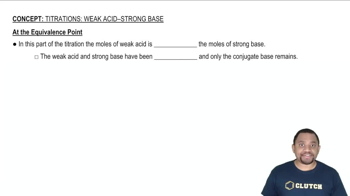A 30.0-mL sample of 0.165 M propanoic acid is titrated with 0.300 M KOH. Calculate the pH at each volume of added base: 0 mL.
Ch.18 - Aqueous Ionic Equilibrium
Chapter 18, Problem 78d
A 30.0-mL sample of 0.165 M propanoic acid is titrated with 0.300 M KOH. Calculate the pH at each volume of added base: equivalence point.
 Verified step by step guidance
Verified step by step guidance1
Identify the reaction: Propanoic acid (C_2H_5COOH) reacts with KOH to form water and potassium propanoate (C_2H_5COOK).
Calculate the moles of propanoic acid initially present using the formula: moles = concentration \( \times \) volume.
Determine the moles of KOH needed to reach the equivalence point, which is equal to the initial moles of propanoic acid since the reaction is 1:1.
Calculate the volume of KOH required to reach the equivalence point using the formula: volume = moles / concentration.
At the equivalence point, the solution contains only the salt (potassium propanoate). Use the hydrolysis of the propanoate ion to find the pH by setting up an equilibrium expression and solving for the hydroxide ion concentration.

Verified video answer for a similar problem:
This video solution was recommended by our tutors as helpful for the problem above.
Video duration:
9mWas this helpful?
Key Concepts
Here are the essential concepts you must grasp in order to answer the question correctly.
Titration
Titration is a quantitative analytical technique used to determine the concentration of a solute in a solution. It involves the gradual addition of a titrant (in this case, KOH) to a solution of the analyte (propanoic acid) until the reaction reaches its equivalence point, where the amount of titrant added is stoichiometrically equivalent to the amount of analyte present.
Recommended video:
Guided course

Acid-Base Titration
Equivalence Point
The equivalence point in a titration is the stage at which the number of moles of titrant equals the number of moles of the substance being titrated. At this point, the reaction between the acid and base is complete, and the pH of the solution can change dramatically, often requiring calculations to determine the resulting pH based on the properties of the resulting solution.
Recommended video:
Guided course

At the Equivalence Point
pH Calculation
pH is a measure of the acidity or basicity of a solution, defined as the negative logarithm of the hydrogen ion concentration. In titration problems, calculating the pH at the equivalence point often involves understanding the dissociation of the resulting salt and the hydrolysis of the conjugate base formed, which can affect the final pH of the solution.
Recommended video:
Guided course

pH Calculation Example
Related Practice
Textbook Question
Textbook Question
A 30.0-mL sample of 0.165 M propanoic acid is titrated with 0.300 M KOH. Calculate the pH at each volume of added base: 5 mL.
Textbook Question
A 30.0-mL sample of 0.165 M propanoic acid is titrated with 0.300 M KOH. Calculate the pH at each volume of added base: 10 mL.
Textbook Question
A 30.0-mL sample of 0.165 M propanoic acid is titrated with 0.300 M KOH. Calculate the pH at each volume of added base: one-half equivalence point.
Textbook Question
A 30.0-mL sample of 0.165 M propanoic acid is titrated with 0.300 M KOH. Calculate the pH at each volume of added base: 20 mL.
Textbook Question
A 30.0-mL sample of 0.165 M propanoic acid is titrated with 0.300 M KOH. Calculate the pH at each volume of added base: 25 mL.
